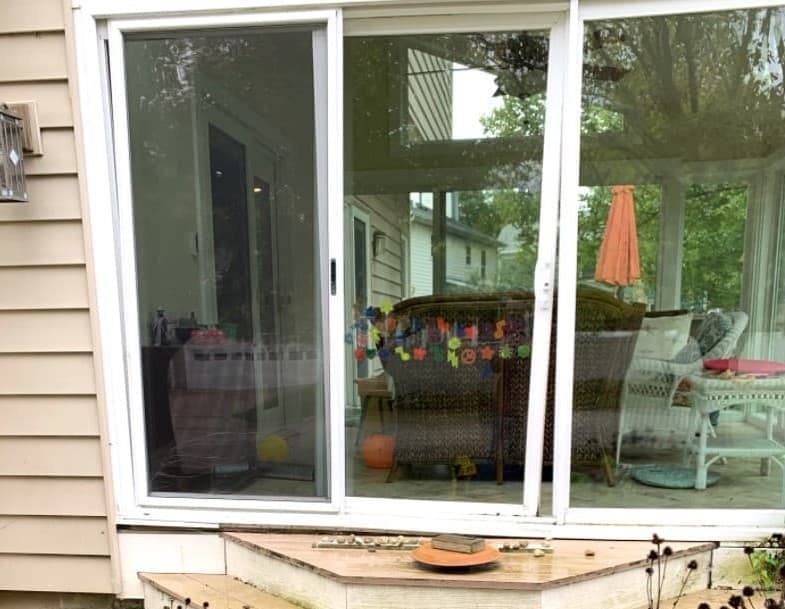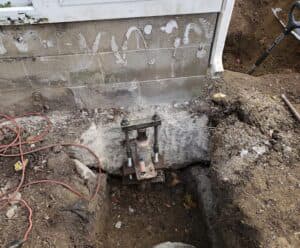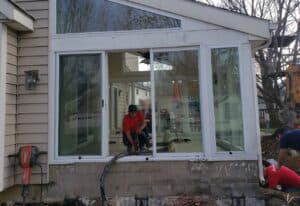
[et_pb_section admin_label="section"]
[et_pb_row admin_label="row"]
[et_pb_column type="4_4"][et_pb_text admin_label="Text"]When your porch starts to settle, it usually happens gradually. You probably don’t even notice it at first; many of us enter our homes through the garage or a side door, rarely using our front entrance. And if it’s a side porch or an enclosed back porch, you may only use it in warmer weather.
Whatever the circumstances, one day you step onto your porch and something isn’t right: a window won’t open, there are cracks forming on the floor or ceiling, or the stairs don’t line up like they should.
If your porch is settling, sinking, or pulling away from your home, you have a foundation issue. Started in 1996, Acculevel has helped more than 35,000 homeowners restore strength and stability to their homes. We’re a family-owned and operated company that specializes in foundation repair, concrete leveling, and waterproofing.
In this article, we’re going to explain how a porch can be lifted, leveled, and repaired. To help illustrate this process, we’ll be referencing a recent repair made at a customer’s home. (All of the photos in this article were taken by Acculevel employees.)
Water - and the erosion it creates- is usually what causes your foundation to sink (we call this settling. As the ground shifts or moves, the foundation resting on it gradually begins sink with it.
Settling in a new home is pretty typical, and not a major issue. Initial settling happens as the weight of the building presses into the ground. But settling IS a foundation problem when it’s not uniform. Uneven settling means one section or corner is more affected than the others.
And uneven settling causes significant stress on your foundation, because concrete is not a flexible material. That’s why cracks form during settling; your foundation cannot bend.
But when your porch settles, it can do more than crack and pull at the foundation. It can actually move away from your home. This is because porches are normally built on a foundation separate from your home’s foundation. This is how the gaps form between the porch and the house.
FYI: Home builders generally construct a foundation for the house. Additional structures like chimneys, porches, and garages are often built separately, on their own foundations.
Other common signs of a settling foundation include doors or windows that “stick.” We’ve explained that your foundation isn’t flexible- but really, none of the materials used to build a home are. The wood and metal that form your window tracks and door frames also experience strain from settling.
This strain means doors and windows will stop functioning smoothly. They may not open, or close, or you may have to struggle to get them to move at all.

In this photo, you can see there is a significant gap forming under the door frame. The frame has been strained until the sliding doors cannot open/close properly.
The best way to repair any settling foundation is with piers. At Acculevel, we recommend helical piers, especially for smaller structures like houses. Push piers are an alternative to helical piers, but in our experience, these can put too much pressure on a home’s foundation. Push piers are attached to the building, and use the weight of the building to leverage the pier into the earth. Most homes do not weigh enough to leverage the piers well, and you know a porch isn’t going to be as heavy as a house!
Helical piers are screwed into the earth until they reach the needed depth (measured by pressure gauge), then attached to the home. Piers (both push and helical) can’t guarantee your foundation will be lifted back up to where it was pre-settling. But they do keep your foundation from settling any further.
Lifting a porch is somewhat easier than a home, because it weighs less. For the case study we’re highlighting, helical piers were installed on the outside corner. Piers require excavation next to the home, to make room for installation.

This is a close-up view of one of the helical piers, after it’s installed and attached to the foundation with a bracket.
If your porch is a single layer of concrete like a patio (called a slab), piers may not be necessary. Piers are usually needed if the porch has structure on top of it- like the sunroom in our example here. This is because the weight of an enclosed porch is too heavy for slabjacking to work.
Slabjacking is a concrete leveling method. Small holes are drilled through the settling slab, and a polyurethane foam is injected to lift the slab back into place.
Our sales director, Nolan Beery, explains the slabjacking process:
We bring up slabjacking in this article, because in some cases, you may need both piers and slabjacking. As piers lift and stabilize the porch, they can create a gap under the center of the porch. If the gap is significant enough, it can cause the porch floor to crack.
Another potential problem is that the porch foundation may have been built first, and the floor poured afterwards. If this is the case, lifting the porch with piers won’t always move the floor with the perimeter foundation.
Need more information about slabjacking, and why you might need it? We explain what makes a concrete slab settle, and how slabjacking is used.
In the photo below, you can see the piers have lifted the corner of the porch and closed the gap; this has restored the sliding doors to function. But the porch had settled several inches, so we know there is at least some empty space below the porch. This was confirmed after the piers were installed, because the porch floor was not entirely level.

The piers stabilized the foundation, closing the gap and allowing the doors to open/close. Slabjacking fills any gaps formed by the movement.
To lift the floor back into position, and prevent it from settling or cracking in the future, our project advisor recommended slabjacking, also. The foam flows into empty spaces and expand, to provide support for the floor and lift it where it has sunk.
In the photo below, you can see the Acculevel crew was monitoring a level on the porch floor during the slabjacking process. Once the work was complete, the crew took a photo to document that the porch is once again level and plumb.

During slabjacking, the crew monitors the process with a level. You will also notice that the crew has been vacuuming up dirt and debris, to keep the job site tidy.
If you have a concrete porch that needs repair, you should schedule an in-home evaluation by a professional foundation repair company. There are multiple variables to consider, and only a foundation expert will know how to properly diagnose the repair service(s) you’ll need.
Do you live in Indiana, or the surrounding areas? If so, you’re probably in Acculevel’s service area! Give us a call at 866-669-3349, or complete our on-line form. We’ll schedule an appointment for you with one of our trained and experienced project advisors. They’ll discuss your concerns, evaluate your home, and help you determine the right whole-home solution for you.
If you don’t live within the Acculevel service area, please make certain the contractor you work with is properly insured and accredited by the Better Business Bureau. One of this organization’s main goals is to create a “community of trustworthy businesses.” Please make sure you review the credentials of any company you hire to work on your home.
[DISPLAY_ULTIMATE_SOCIAL_ICONS]
[/et_pb_text][/et_pb_column]
[/et_pb_row]
[/et_pb_section]